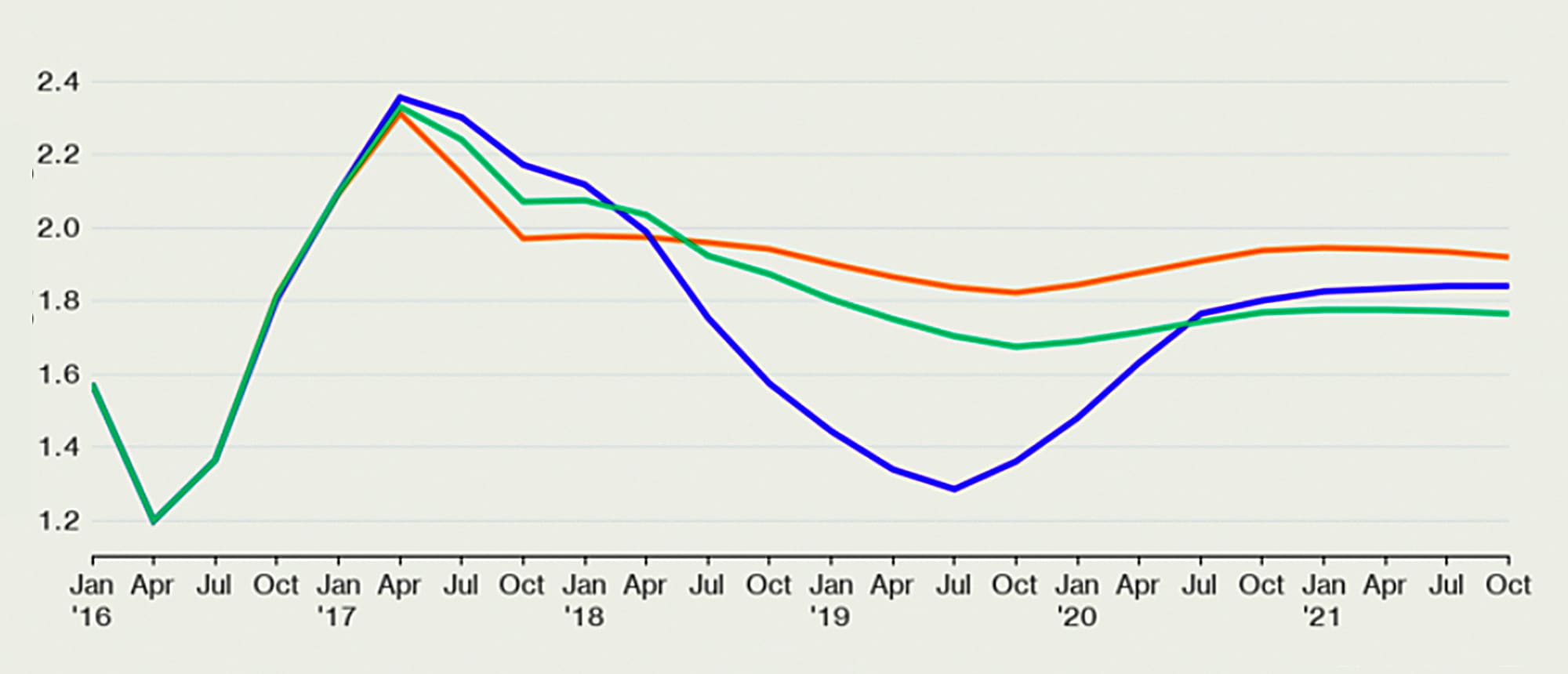Can “Trumponomics” Extend The Recovery?
Donald Trump was elected President of the United States as the U.S. economy headed into its eighth year of expansion following the deepest and most protracted recession of the post WWII era. Since the start of the recovery in June 2009, real GDP growth has averaged a reliable 2.1 percent, and the labor market has clawed back all of the 8.7 million jobs that were lost in the aftermath of the financial crisis. Inflation has remained low, and the official unemployment rate had fallen to just 4.6 percent in November 2016. Goldilocks might have declared the porridge to be just right.
To some observers, this looked like a pretty decent backdrop against which to make the case for a continuation of the Obama-era policies that many credited with finally healing the wounds of the Great Recession. While not blazing hot, the American economy was growing and creating jobs, and many believed that Hillary Clinton could best her opponent by pledging to build on the achievements of the past with a fiscally responsible, steady-as-she-goes agenda. Yuge changes were unnecessary, she insisted. America was already great.
Many voters had other opinions, along with vastly different lived experiences. The tailwinds that were supposed to propel the first woman into the Oval Office met their fiercest resistance in the so-called Rust Belt states, where people who had seen their lives and their communities transformed by decades of disinvestment and disenfranchisement decided to roll the dice on a foul-mouthed reality TV star with no experience in public office.
I’m not going to spend time diagnosing the decades-long forces that gave rise to Donald Trump. For that, I recommend Thomas Frank’s excellent book, Listen, Liberal or Matthew Stoller’s outstanding piece in The Atlantic, “How Democrats Killed Their Populist Soul”. What I am interested in pursuing here is a different question altogether – now that we have President Trump, what will he and his Republican colleagues do? Which constituencies will Trump fight for, and can the GOP hold together to deliver any substantive legislative victories for the new president?
Some argue that Trump’s policies pose major downside risks to the U.S. economy. Others see the potential for an upside surprise, at least in the near term. What will President Trump do, and will his policies work as advertised? No one can say for sure. What we do know is that the voters who delivered the White House to Mr Trump are counting on him to deliver real improvements in their lives. This means that simply extending the recovery may not be enough to hang on to the Obama voter who crossed over to give her vote to Donald Trump. To retain the support of these voters, Trump’s policies must go beyond simply prolonging the recovery. They must promote the kind of growth that raises the living standards of millions of struggling Americans, lessens the share of total income going to profits and reverses the yawning gaps in the distribution of wealth and income. Unfortunately, these are not the stated goals of the Trump administration, so the remainder of this essay will focus on the narrower question: can “Trumponomics” extend the recovery?
Where are we today?
At 93 months of age, the U.S. economy is in the midst of its fourth-longest expansion since 1850. If we can extend the recovery for another two-and-a-half years, we will break the alltime record. For that to happen, the economy’s tailwinds must remain stronger than its headwinds. The broad consensus today is that the economy is very close to its full employment potential. And while few see a downturn in the near future, Goldman Sachs puts the risk of recession at about 1-in-4 through 2018Q3.
Whereas Janet Yellen recently gave the economy “a little more room to run,” she now argues that it is close to its potential, and she is preparing markets for a series of rate hikes beginning in March. Such a tightening cycle is consistent with the belief that the Fed’s dual-mandate has been broadly achieved and that there is little room for an acceleration of growth. Goldman’s Hatzius and Pandl (2016) agree:
“While expansions do not die of old age, history shows that they are at greater risk when spare capacity is exhausted, as it probably is now. So it is especially important to monitor whether growth may be running out of steam.”
Before we move to an analysis of “Trumponomics”, we should pause and ask two important questions. First, are we really near our full employment potential? Second, is there room for “Trumponomics” to extend the recovery?
It is probably safe to say that the consensus opinion among Fed economists and academic economists alike is that the economy has essentially returned to its full employment potential. That belief is consistent with the data reported in Figure 1, which shows that the gap between actual and potential GDP has been nearly eliminated.
But there is a problem here, at least in my view. The data depict an economy that is close to bumping up against its long-run ceiling, a constraint that many believe will frustrate Trump’s effort to get things running much hotter. However, there is something more we should know about the position of this ceiling.
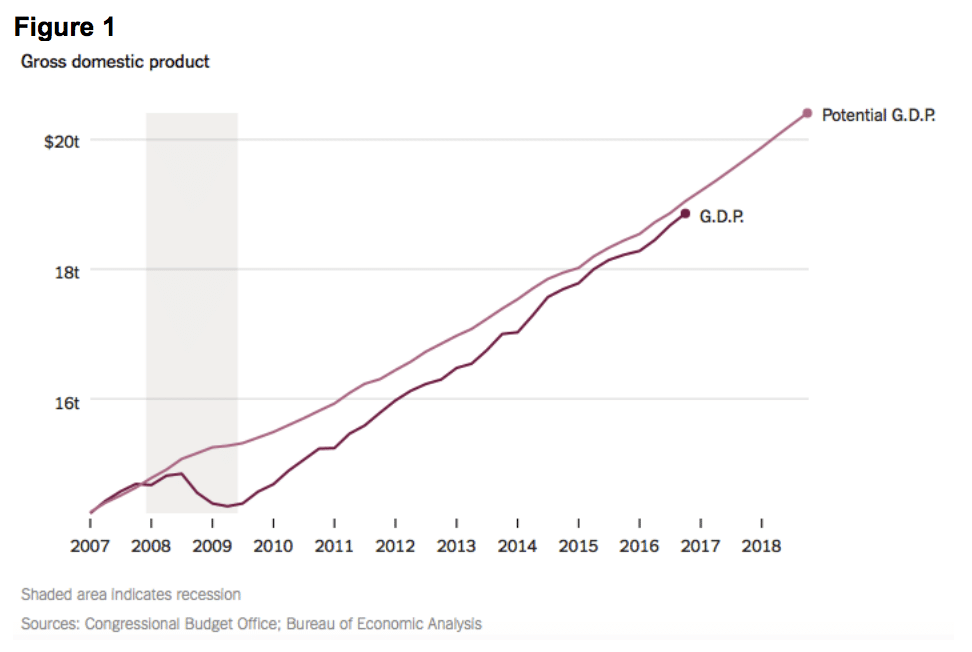
As Larry Summers has shown, the bulk of the progress that was made in closing the output gap came, “not through the economy’s growth but through downward revisions in its potential” (2014, p. 66). In other words, as Figure 2 shows, output is near its full employment ceiling not because the economy rose to its potential but because we lowered the definition of what we believe our nation’s productive capacity to be. It’s a bit like giving up on the idea that your child is capable of achieving straight As, relaxing the goal to a 2.0 GPA, and then celebrating when he presents you with across-the-board Cs. Junior is now a high achiever!
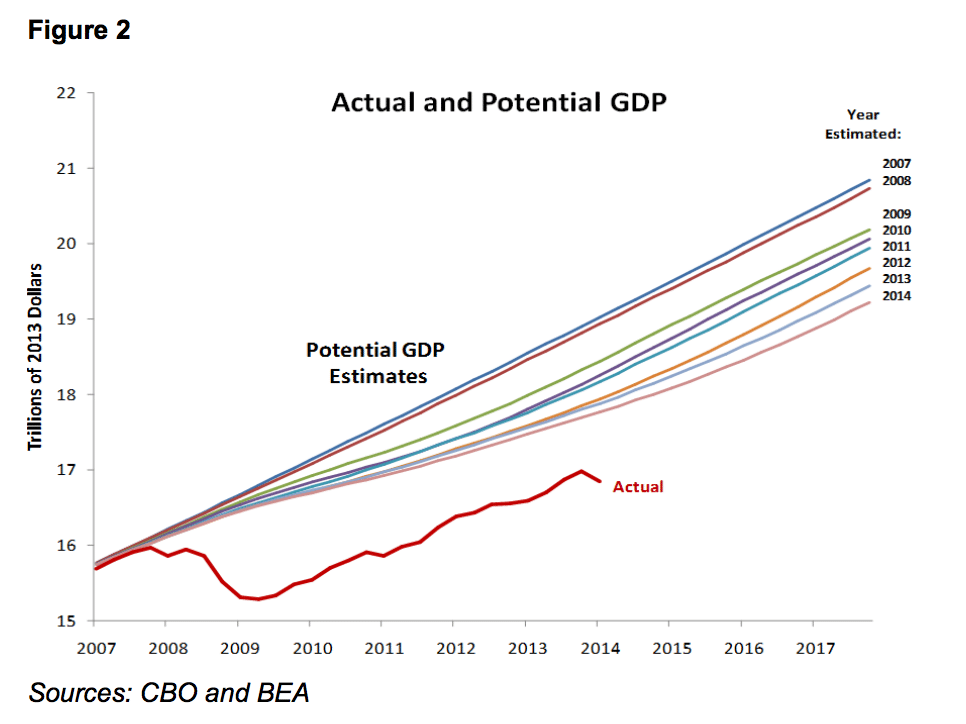
To see what a difference these downward revisions make, consider what it would look like if today’s output gap was measured using the 2007 estimate of potential GDP (shown in Figure 2) rather than the revised estimate shown in Figure 1. Instead of full employment, we would be looking at a GDP gap of roughly 14 percent, or nearly $2 trillion.
Why did potential GDP get revised downward in the first place, and how much of that lost potential could be clawed back? The short answer to the first question is that the failure to bring about a swift recovery from the Great Recession imposed lasting harm on the economy. The answer to the second question may be among the most important of our time. And while I cannot offer a rigorous empirical estimate here, both history and theory suggest that there are ways to reverse at least some of the damage. Investments in infrastructure, education, R&D, etc., should help the U.S. reclaim some of the lost potential by boosting long-run productivity.
Even without the kinds of investments that would help nudge potential GDP northward, it still may be possible to safely accelerate growth. Whereas Goldman and Yellen10 see little slack left in the economy, new research from Dantas and Wray (2017) suggests that the U.S. labor market is still far from full employment. In their view, “we are not even close” to full employment, and “reaching full employment would require, on average, gains in payroll employment of 420,000 jobs per month for the next four years”. Nick Buffie (2016) agrees, arguing that, despite the low official unemployment rate, the labor market remains quite weak. If these assessments are correct, then it should be possible to squeeze more growth out of the economy in the short term. It also means that “Trumponomics” could surprise on the upside.
What is Trumponomics?
Less than three months into the Trump presidency, there is no formal budget and no precise blueprint that describes the full range of policies and programs that the administration intends to pursue. “Trumponomics”, therefore, is still very much a moving target, although we are beginning to see the broad contours of an economic agenda taking shape. Harvard economist and former U.S. Treasury Secretary, Larry Summers, sees “enormous uncertainty” ahead, adding:
“This is probably the largest transition ideologically and in terms of substantive policy in the last three quarters of a century.”
What is the ideological philosophy behind “Trumponomics” and how does it represent a break from the guiding principles of the last 75 years? As a presidential candidate, Donald Trump explained his thinking in this way:
“It’s called priming the pump. Sometimes you have to do that a little bit to get things going. We have no choice – otherwise, we are going to die on the vine…The economy would be crushed under Hillary. But no matter who it is, the debt is going to go up.”
To some economists, Trump’s economic approach sounded downright Keynesian.12 Channeling Bernie Sanders, he called for a trillion-dollar boost to infrastructure spending, along with (the usual Republican call for) deregulation and massive tax cuts. He was unapologetic about running budget deficits and adding to the national debt. But he combined the more Keynesian-inspired fiscal maneuvers with a protectionist trade agenda and a nationalist pledge to seal the borders and deport millions of undocumented people. On Social Security and Medicare, he sounded a more compassionate tone, vowing no cuts, and he even talked about bringing the U.S. into the 20th century by supporting paid family leave. As Figure 3 shows, this blend of policy positions makes it difficult to situate “Trumponomics” within a conventional ideological matrix.
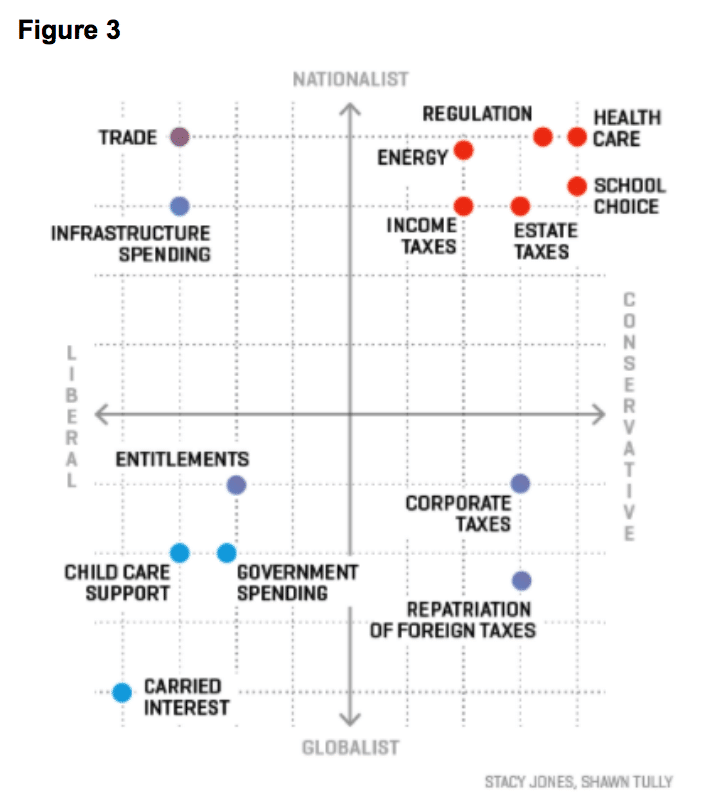
So, what exactly is “Trumponomics”? The short answer is that it is too early to put concrete numbers the full range of proposals that will be coming down the pike. Mick Mulvaney, director of the Office of Management and Budget (OMG) is working on those numbers now, promising that “[a] full budget will contain the entire spectrum of what the president has proposed”. An early look at the numbers could come mid-March, when the Trump administration is expected to release a sneak preview of its plans in the form of a “skinny budget”.
For now, we know that the President’s FY18 Budget will call for a 10 percent increase in defense spending, along with equivalent ($54B) offsetting cuts to other federal agencies. The president has also pledged to make long-overdue investments in our nation’s infrastructure, promising, “we’re going to start spending on infrastructure – big”. Democrats have balked at both proposals, preferring traditional government-funded infrastructure investment to the widely-anticipated public-private schemes that are expected to form the basis of the Trump model. And they oppose the cannibalizing of the non-defense, discretionary budget as a means of allocating more resources to the military. As House Minority Leader Nancy Pelosi (D-CA) put it:
“A $54 billion cut will do far-reaching and long-lasting damage to our ability to meet the needs of the American people and win the jobs of the future. The President is surrendering America’s leadership in innovation, education, science and clean energy.”
Thus, Democrats are bracing for massive cuts that could more than offset any stimulus that might result from higher spending on infrastructure and defense. Just how big could these cuts be?
Some (Bolton, 2017) have suggested that Trump’s budget will closely track the Heritage Foundation’s Blueprint for Balance, which calls for $10.5 trillion in cuts over the next 10 years. The already-tiny amounts spent on the Corporation for Public Broadcasting (CPB), the National Endowment for the Arts (NEA) and the National Endowment for the Humanities (NEH) would be eliminated completely, and the departments of Justice, State, and Transportation would suffer deep cuts.
As all good Keynesians know, one person’s spending is another person’s income. So how is cutting $10.5 trillion in spending supposed to help to extend the recovery?
Ronald Reagan to the rescue?
During their first presidential debate, Hillary Clinton criticized Donald Trump’s approach to growing the economy, labeling it “Trumped up trickle down” economics. It was an obvious jab at the kind of supply-side policies that characterized the Reagan years. Rather than fight the comparison, Trump focused on the bigness of his agenda:
“By the way, my tax cut is the biggest since Ronald Reagan – I’m very proud of it.”
Hillary maintained that she and Trump had different economic philosophies, adding that giving the biggest tax cuts to the top percent “is not how we grow the economy.”
Nobel laureate Paul Krugman also compared Trump’s agenda with Reagan’s, predicting Trump’s policies “won’t actually do much to boost growth because [interest] rates will rise and there will be lots of crowding out. Also a strong dollar and bigger trade deficit, like Reagan’s morning after Morning in America.” And while it is true that interest rates rose sharply and America’s trade deficits ballooned under Reagan, it is also true (as Figure 4 shows) that the economy grew at a good clip during much of the Reagan era. Remember, Reagan was reelected in a landslide.
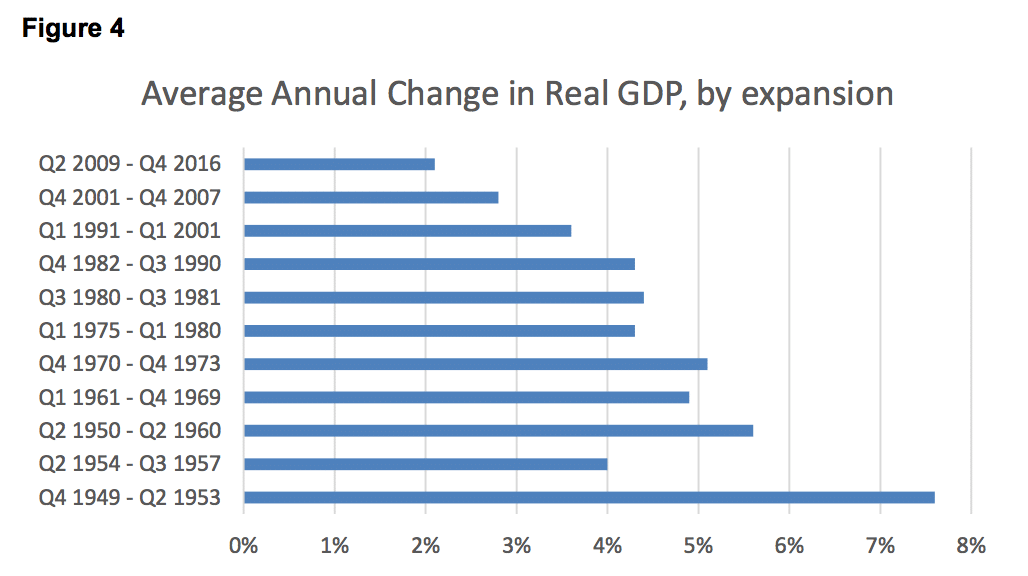
According to Harvard’s Ken Rogoff (2016), “Trumponomics” has the potential to really juice the American economy. “Even if you oppose Trump’s policies,” he says, “you’ve got to admit they are staunchly pro-business.” For this reason, Rogoff has cautioned against the kind of doomsday scenario described by Krugman, warning, “[b]eware of pundits who believe Trump will bring economic catastrophe”.
What Rogoff doesn’t say, however, is that the benefits of the Reagan expansions went overwhelmingly to those at the top of the income distribution. Tax cuts for the wealthy, attacks on unions, cuts to programs aimed at helping the poor and an obsession with deregulation and “free markets” shifted the balance of power toward owners of capital and ushered in an era of increasing insecurity and growing inequality for the working class. Figure 5 shows the remarkable shift in the distribution of income that began under Reagan.
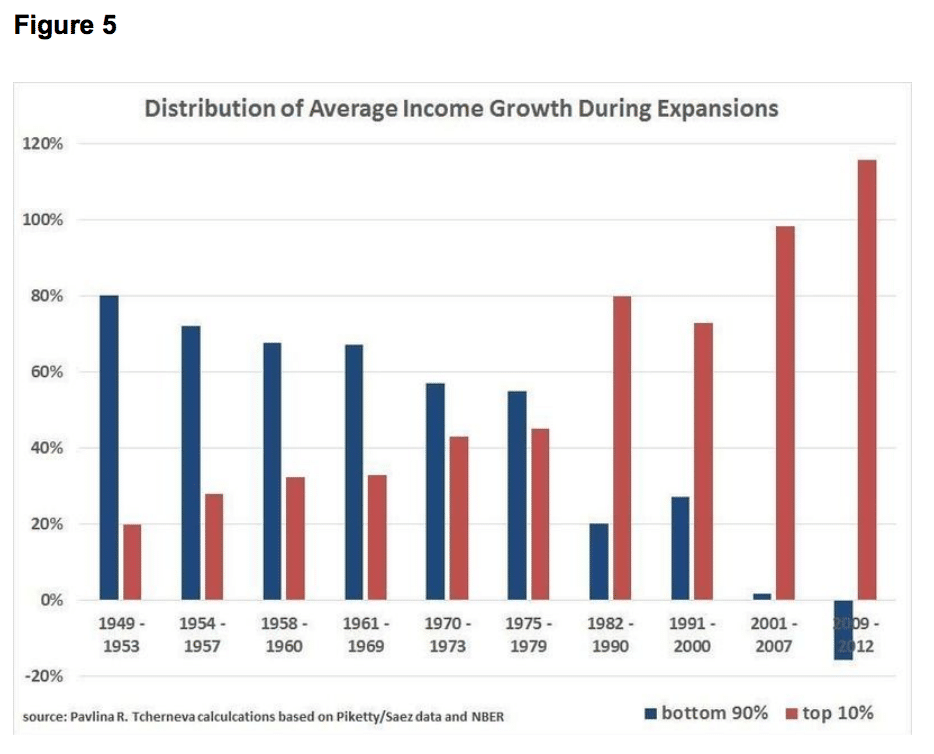
Prior to the election of Ronald Reagan in 1980, the vast majority of Americans – the bottom 90 percent – received the lion’s share of the income generated in a growing economy. It wasn’t a utopia – there were still periods of high unemployment and maldistribution that left millions impoverished – but the bulk of the income produced during an economic expansion went to the vast majority of the population. After “Reaganomics,” however, things changed. The benefits of a growing economy were no longer broadly shared, as the top 10 percent began hauling in more than the bottom 90 percent. It’s a trend that has not only continued but one that has generally worsened over time.
Donald Trump isn’t promising to reverse these trends, though he is claiming that his policies will substantially boost the economy and improve life for millions of “forgotten” Americans. Specifically, the president has championed an agenda that the he says will deliver 3.5-4.0% growth, something the U.S. hasn’t experienced on any kind of sustained basis since the “Clinton Boom”. Judging from the details we have thus far, “Trumponomics” appears to be just what Hillary Clinton called it, a Trumped-up version of Reagan’s trickle-down recipe, with an added ingredient or two.
What do we know about Trump’s recipe for the economy? First, we know that the Trump administration has embraced the House Republican proposal to reduce the number of tax brackets from seven to three and to lower the marginal tax rate on the highest income earners from 39.6 percent to 33 percent. We also know that the president is proposing to eliminate the estate tax, cut the corporate income tax rate from 35% to 20%, and allow businesses to repatriate offshore profits at 10%. Finally, we know that even his health care plan is really just a massive tax cut for the rich. According the Center on Budget and Policy Priorities (2017), the 400 highest income earners in America would see an average tax cut of about $7 million a year if the Republicans succeed in repealing the Affordable Care Act. And while Trump says that his policies will improve life for the “forgotten Man”, the Tax Policy Foundation (TPF) has shown that the little guy isn’t getting much of anything when it comes to the proposed tax reforms. Indeed, TPF estimates that after-tax incomes for the top 1 percent of earners could surge by as much as 16 percent, while the bottom 80 percent could see an after-tax lift of just 1.9 percent. Meanwhile, the bottom quintile would end up with a paltry 0.8 percent boost in their take-home pay.
And then there’s Trump’s proposal for a regressive Border-Adjustment Tax (BAT).
“Like any tax, the tariff burden does not fall uniformly across goods, but falls more heavily on particular goods and the populations that purchase them” (Furman, et al. 2017).
Hence, the tariff burden is essentially a regressive tax. Furman, et al. estimate the distributional impacts of current US tariffs, which amount to $33 billion per year or around 0.2 percent of GDP. They find that tariffs cost the bottom 10-20 percent of households about $95 per month, while middle-income households pay about double that amount ($190 per month) and the richest 10% pay about $500 per month. While the rich pay more in absolute terms, Figure 6 shows that the tax is substantially regressive when you consider the burden relative to income. Taken together, Trumponomics includes a hefty serving of Reagan-inspired trickledown economics along with a side of protectionism, a dash of military Keynesianism and a social agenda that is anti-worker and anti-immigrant.
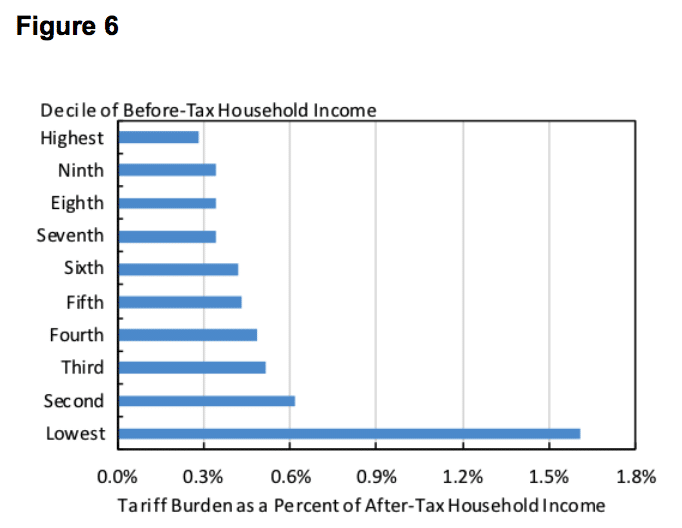
While the CEOs of some of America’s retail giants have taken aim at the proposed border tax, Wall Street appears to love where Trump is trying to take the economy. For example, Jamie Dimon, chairman and CEO of JPMorgan Chase & Co., says that Trump’s proposed tax cuts, deregulation and infrastructure investment have reawakened animal spirits. “If he gets it done, even part of it, it will be good for growth, good for jobs, good for Americans.”
Is it possible? Can Trump’s supply-side tax cuts and deregulation unleash a current of tailwinds strong enough to propel the economy forward even as they’re coupled with massive cuts in other programs (not to mention mass deportation and a possible trade war)? Most experts find it unlikely.
Can “Trumponomics” extend the recovery? No consensus among experts
For the most part, what follows is a brief overview of the macroeconomic consequences of “Trumponomics” as analyzed by the research staffs at Moody’s Analytics and Goldman Sachs. Both have produced forecasts for a range of macro variables – including real GDP, unemployment, inflation, interest rates, etc. – using different assumptions about what might ultimately come to pass as “Trumponomics”.
Over at Moody’s, Zandi, et al. (2016), looked at three scenarios. The first hews most closely to the agenda espoused by Donald Trump in speeches, interviews, tweets, etc. This scenario is referred to as the “Full Monty Trump” in Figure 7. A toned-down version is also examined, one in which Trump succeeds in getting his basic agenda adopted, though on a smaller scale. This is the “Trump Lite” scenario below. Finally, the Moody’s team simulates a “Washington Reality” scenario that assumes the kind of budget neutral program that Congress could actually pass.
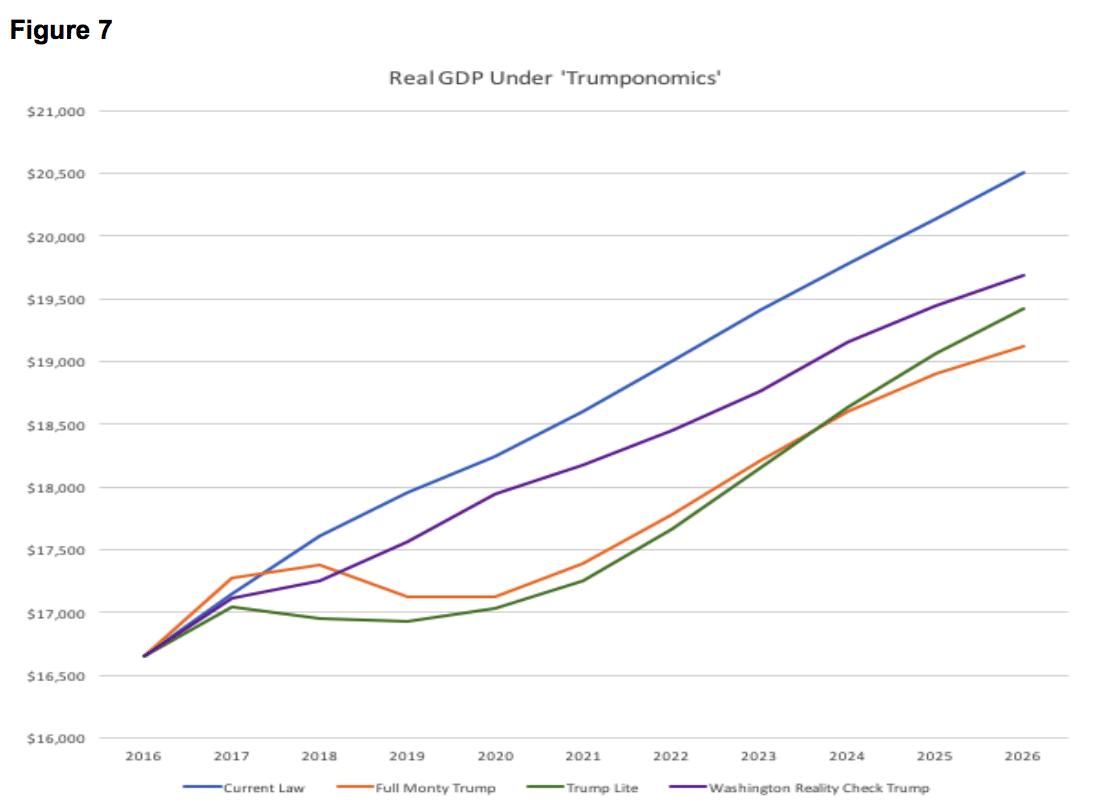
In all three cases, Trump’s policies produce outcomes that are worse (over the full forecast horizon) than the baseline scenario, which assumes no change in current policy. Even in the best-case scenario (Washington Reality) where a recession is avoided, the economy averages just 1.7 percent annual growth over 10 years, well below the promise land of 3.5-4.0 percent. Under the worst-case scenario, the one that assumes all of Trump’s proposed policies become law, including tariffs and the deportation of millions of undocumented people, the economy enjoys a year or two of improved growth, but “a lengthy recession” follows, with 3.5 million fewer jobs and an unemployment as high as 7% by the end of his first term. The economy also does more poorly under the “Trump Lite” scenario, with Moody’s predicting a deep recession beginning in 2018 as unemployment climbs to 8.9% by 2020.
You might wonder whether Moody’s is uniquely pessimistic about the prospects for growth under a Trump administration. That’s a fair question, so let’s look at the analysis done by Goldman Sachs. Over at Goldman, Haztius and Stehn (2017) ran their own simulations, using the Federal Reserve’s economic forecasting model. Their results are shown in Figure 8.

Like Moody’s, the Goldman team found that Trump’s policies are a net negative for growth relative to the baseline (status quo). To get the extreme case, Goldman ran a “Full” Trump scenario that included $450 billion in fiscal stimulus (a combination of infrastructure investment and tax cuts), some reciprocal tariffs, and immigration restrictions that reduce the size of the labor force by 2.5 million compared with the Fed’s baseline projection. As Figure 9 shows, the Full Trump scenario juices the economy in the near term, but the effects of the stimulus quickly diminish, as the model assumes that limits on labor force growth begin to bind, slowing overall growth. As with Moody’s, Goldman doesn’t expect Trump to get everything he wants, so they also simulated a more realistic agenda (GS Expectation), which extends the economy’s growth rate above 2 percent for about an additional year. “Our simulations suggest that Mr Trump’s policies could boost growth slightly in 2017 and 2018, but are likely to weigh on growth thereafter if trade and immigration restrictions are enacted,” wrote Hatzius and Stehn.
Goldman differs from Moody’s in that “Trumponomics” does manage to extend the recovery through 2020, however growth doesn’t approach anything like the 3.5-4.0%. The bottom line is that, compared with the status quo scenario, both Goldman and Moody’s predict a smaller economy at the end of Trump’s first term.
It’s an astonishingly gloomy outlook that is shared by a number of high-profile academic economists. For example, Joseph Stiglitz, speaking at the ASSA meetings in Chicago, said, “There is a broad consensus that the kind of policies that [President Trump] has proposed are among the policies that will not work.” Harvard Professor and former U.S. Treasury Secretary, Larry Summers, believes financial markets are overly enthusiastic about “Trumponomics”, comparing their zeal to a “sugar high” that will dissipate as reality sets in. That reality includes the harmful effects of Trump’s immigration policies and his protectionist impulses, which many believe could drive up prices (of labor and imports), fueling higher inflation and causing the Fed to hike rates more aggressively. Finally, Paul Krugman notes that “Trumponomics” ultimately relies on a burst of supply-side tailwinds, powered by huge tax cuts, which, in his view, are unlikely to propel the economy through the gale force headwinds that will result from trillions in spending cuts:
“But the tax cuts will go to the wealthy, who won’t spend much of their windfall, while the spending cuts will fall on the poor and struggling workers, who will be forced into sharp cutbacks in spending. The overall effect on demand is therefore likely to be negative, not positive.”
Not everyone shares this glum perspective on “Trumpnomics”. As I noted above, Harvard’s Ken Rogoff remains optimistic. While he believes that “inflation is a near certainty”, he sees the potential for a doubling of growth, at least temporarily, cautioning against “pundits who believe Trump will bring economic catastrophe”.
Conclusion
President Trump has promised to “Make America Great Again”. Part of this pledge involves getting the U.S. economy growing at rates it hasn’t experienced in almost two decades. Many economists are skeptical of “Trumponomics” and doubt that his policies can extend the recovery, much less deliver the 3.5-4.0% growth he has crowed about.
My own view is that economists have probably displayed too much pessimism when it comes to the potential for higher economic growth. But that does not mean that I side with Rogoff entirely. As I see it, both Rogoff outcomes are possible. That is, “Trumponomics” – especially tax cuts and deregulation – could produce windfall gains that energize asset prices (stocks and even real estate), generating a strong – if temporary – wealth effect that leads to a surge in aggregate spending. If there is more slack in the economy than Moody’s or Goldman imagine, it seems reasonable to think that growth could surprise to the upside – 3.5 percent does not strike me as inconceivable.
But, as Figure 6 reminds us, growth alone does not prevent economic catastrophe. In other words, both outcomes – higher growth with catastrophic consequences – are possible. And the just-released “skinny budget” from the Office of Management and Budget (2017) certainly looks like a catastrophe for the sick, the poor, the middle-class and the planet. It includes a Reaganesque beefing up of the defense budget, along with massive cuts in non-defense discretionary spending. Couple this with the yet-to-be-announced cuts to non-discretionary spending (Social Security and Medicare) plus Trump’s proposed tax cuts, and you have Reagan on steroids, a full-throated trickle-up program designed to lock in gains for those already at the top of the income distribution. It may elevate growth, for a time, but it will be a catastrophe nonetheless.

